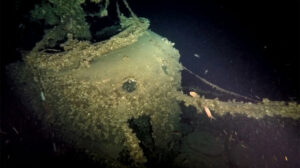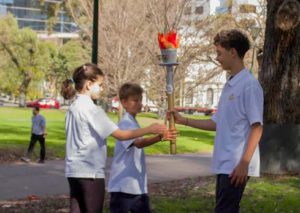A British submarine was found whose traces disappeared in October 1943 while on a secret mission and offensive patrol in the Aegean Sea. It is the HMS TROOPER, spotted at a depth of 253 meters in the Icarian Sea and is the eighth sunken submarine discovered by Kostas Thoktaridis‘ submarine research team.
As Mr. Thoktaridis describes to APE-MPE, the 84-meter-long TROOPER is cut into three distinct sections, bow, middle section and stern, which confirms a very violent sinking, after a explosion of a mine. The location of the wreck, apart from solving a decades-old mystery, helps to bring an epilogue for families of the victims. “It is with great emotion that I learn that the distinguished Greek researcher Kostas Thoktaridis and his team have solved an 81-year-old mystery and discovered the location of the wreck of the British submarine HMS Trooper. Knowing the location of the final resting place of the men of the submarine will help to provide an epilogue for the surviving relatives and descendants and serves as a timely reminder of this special class of men who made the ultimate sacrifice. Resurgam,” George Malcolmson, former director of archives at the Royal Naval Submarine Museum, tells AP-MPA.
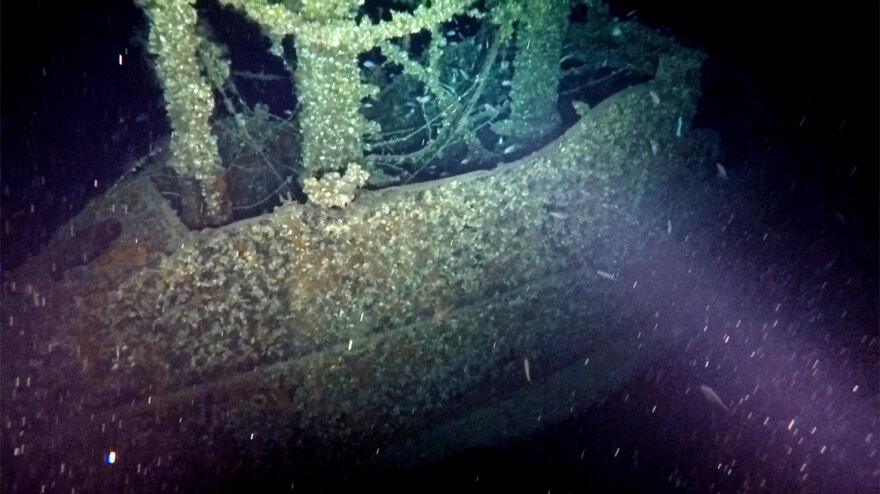
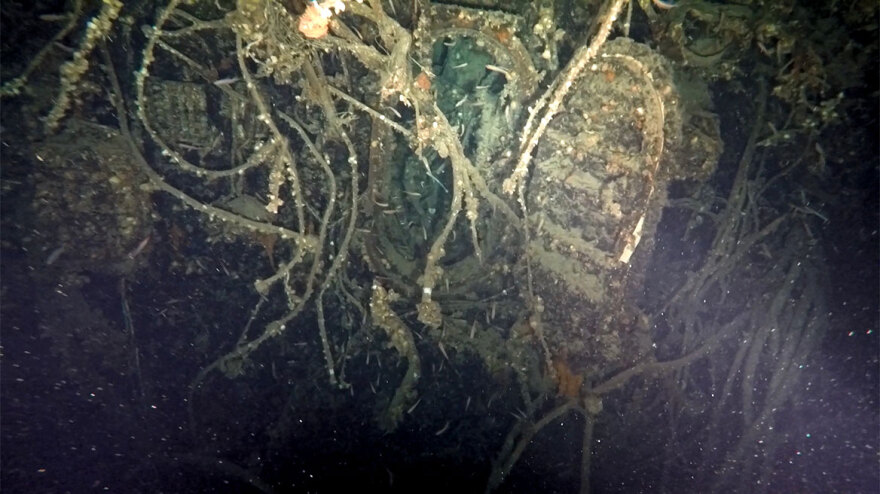
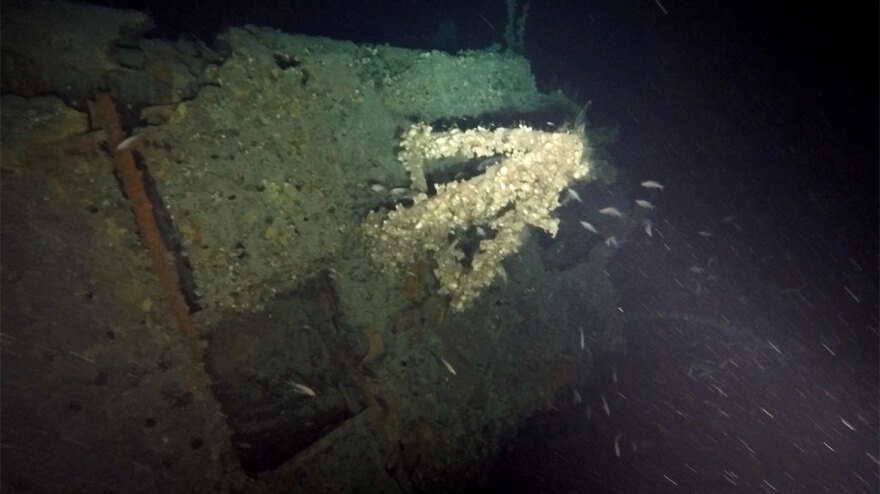 For his part, Richard Wraith, a CBE in the Royal Navy and son of the TROOPER’s captain, told the AP:
For his part, Richard Wraith, a CBE in the Royal Navy and son of the TROOPER’s captain, told the AP:“I have been aware for many years of the painstaking efforts of the search team to locate the submarine wreck and now I am very pleased and excited that their efforts have been rewarded. I hope that the family members of those who perished with my father will be able to use the final location of the TROOPER as a landmark to help lay to rest the memory of their loved ones.”
Throughout the investigation, no intervention or disturbance of any kind was made to the wreck, as it is a watery grave of the 64 men of the crew of the submarine TROOPER. Among them was volunteer Australian Officer Lieutenant John Stuart Ryder, 22 years old.
The historical background of the time
The capitulation of Italy on 8 September 1943 opened the Aegean Sea, as the Germans were determined to take control of the Dodecanese from the Italians and were unwilling to allow the presence of Allied troops on the Aegean islands.
In late September, the British were informed of the gathering of German landing craft in the ports of Piraeus and Crete and the loading of troops and supplies, apparently destined for the Dodecanese. HMS TROOPER, under Lieutenant John S. Wraith, sailed from Beirut on her eighth offensive patrol on 26 September and was ordered to sail into the Aegean. At the same time, however, the German minesweeper DRACHE was carrying out mine laying in the Icarian Sea.
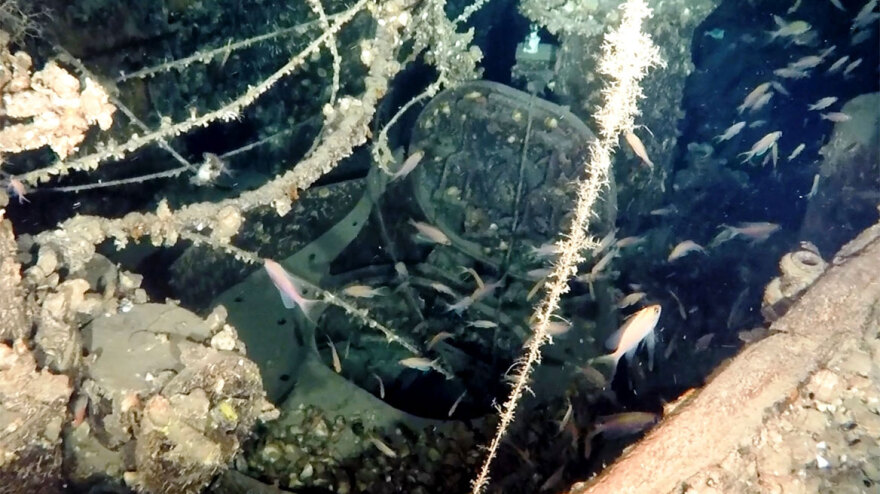
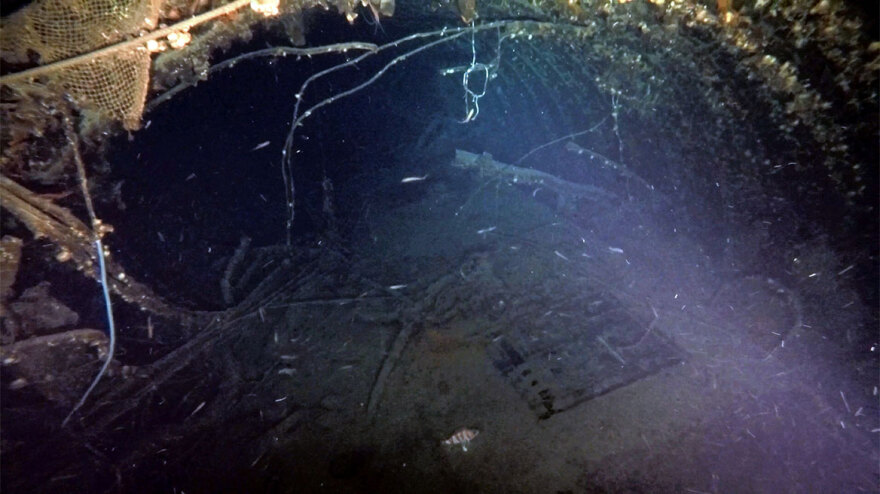
 The last special secret mission
The last special secret mission
The commander of the submarine, in addition to the offensive patrol in the Aegean, was assigned to transport three agents as well as valuable cargo to be landed at Kalamos Evia. On the evening of 30 September 1943 at 23:00, TROOPER arrived at the predetermined area and gradually landed on shore Major Georgios Diamantopoulos of the Greek intelligence service, who had been seconded to the British SOE on a special mission. He was to act alone in carrying out Operation Eruption. In addition, the British submarine landed the soldier of the Greek “Ieros Lochos” Lieutenant Emmanuel Vais and a radio operator, code-named “Thomas”, carrying with them 400 kilograms of supplies.
The landing was successfully completed at 03:00 on 1 October 1943… They were the last people to get out of the submarine alive.
The Greek agent
Major C. Diamantopoulos (nicknamed Toby) was not a random choice. He was a graduate of the Technical University of Metsovion (engineering), spoke German, English, Italian and French, and was trained in secret warfare. An experienced warrior, he was a former artillery squadron commander in the Albanian front, had distinguished himself in the Middle East, and was commander of III Squadron in the Western Desert.
 (Lieutenant Colonel George Diamantopoulos)
(Lieutenant Colonel George Diamantopoulos)
Dangerous mission in Athens
With coded messages and under utmost secrecy, G. Diamantopoulos managed to infiltrate occupied Athens and make contact with important personalities such as: FOTIADIS, SPIROPOULOS, KALKANDIS, MIKROULIS, RANKIDZIS, ARONIS, KARAMANOULIS, KIFONIDIS, PANAGOPOULOS, DOXIAIDIS, IOANNIDIS, EBERT, GEORGAKIS, Archbishop DAMASKINOS, PANAGAKOS, VENTIRIS, SPILIOTOPOULOS, GRIVAS, TAMPAKOPOULOS, and KIROU, gathering information regarding the military situation of the Germans in Greece. Additionally, he delivered 900 gold pounds and a wireless radio to organizations in Athens to support the secret war. The second part of Diamantopoulos’s mission was to collect information regarding the investigation into the assassination of IOANNIS TSIGANDES. The British posed specific questions in writing to certain individuals in occupied Athens, with the objective of uncovering the truth regarding the betrayal and murder of IOANNIS TSIGANDES.
The last voyage of the submarine Trooper
On 5 October 1943, the British had information about a new German landing operation with the possible target of Leros. Thus, the submarine TROOPER was ordered to undertake a patrol between Donousa and Ikaria. From then on, TROOPER’s trail disappeared and when she was due to return to Beirut on 17 October, when she did not turn up, she was considered lost.
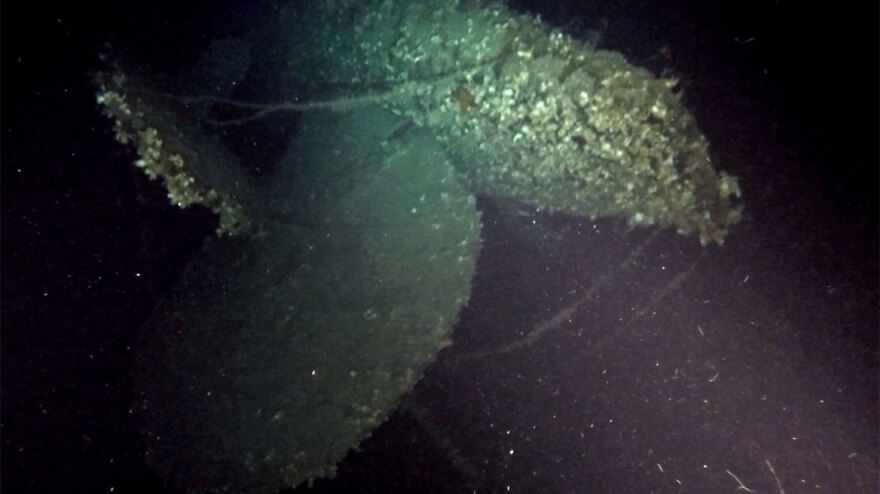

 Tracing through the files
Tracing through the files
The historic search for the Trooper was launched in 1998 by the UK and the first underwater search was carried out in 2000. Since then there have been a further 14 failed expeditions to the Dodecanese. The search had focused on the minefields of Leros and then Kalymnos and Kos. 10 sea minefields were searched without finding the submarine Trooper.
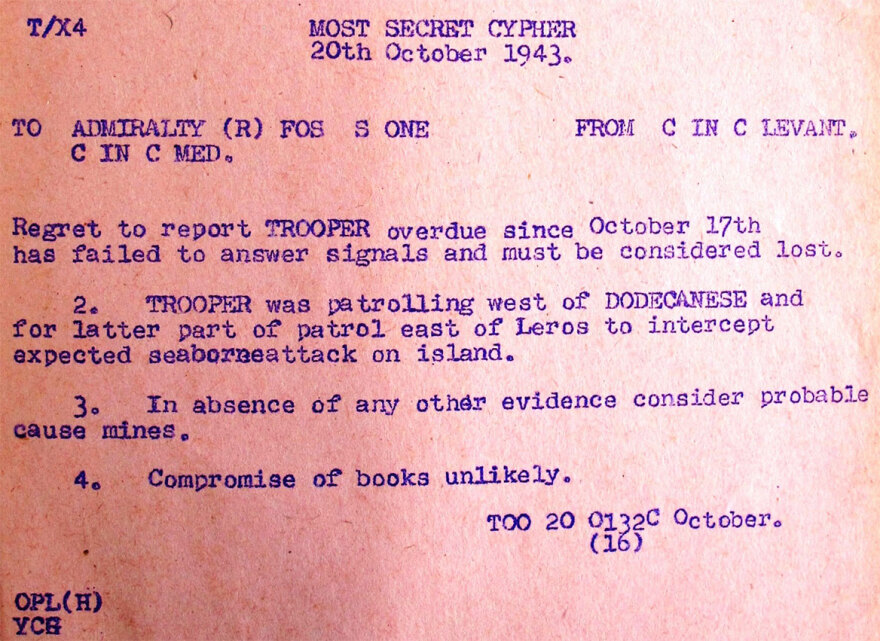 Seligman Theory
Seligman TheoryAt dawn on October 14, 1943, an event took place which was the cause of the disorientation of all research in connection with the sinking of the TROOPER.
The LS8, belonging to the Levant Schooner Flotilla (LSF), had an encounter with a British “T” class submarine that surfaced alongside it in Alinda Bay, Leros. The skipper of the schooner and commander of the flotilla, Lieutenant Commander Adrian Seligman, described in his book “War in the islands” his encounter with the submarine, which he believed to be HMS TROOPER, as he said he recognised the loud and gruff voice of Lieutenant Wraith. This information was adopted as it coincided with the order the British Admiralty had sent to TROOPER, and post-war this version was further strengthened when the mines in the area became known.
The search starts all over again with a new scenario and a change of sea scope
The Seligman version prevailed in the relevant literature, but it proved to have a significant weakness. Researchers S. Vougidis and K. Thoktaridis, studying the logs and reports of British submarines, found that in the report of the captain of HMS TORBAY there was the incident at Leros – exactly as Seligman described it. It was not the TROOPER but the same type of submarine, the HMS TORBAY.
As Spyros Vougidis, a naval officer, tells APE-MPE: “We came to this novel version of the sinking of the submarine after a persistent and detailed analysis of the movements of all those involved and the use of a very large volume of archival material.”
A further element that troubled the investigation was that the TROOPER gave no signs of life after being spotted from the air on 4 October 1943. It was not seen by anyone and did not attempt any attacks while in an area through which enemy units were demonstrably passing. Unlike TROOPER, the submarines UNRULY, UNRIVALED, UNSPARING and TORBAY operating in Greece during those days had regular interaction with the enemy either through their detection or through their attacks. Only TROOPER remained silent and unseen for so many days in an area where there was an intense and constant enemy air presence and dense shipping traffic. This confirmed the new theory that the TROOPER had not reached Leros after all.
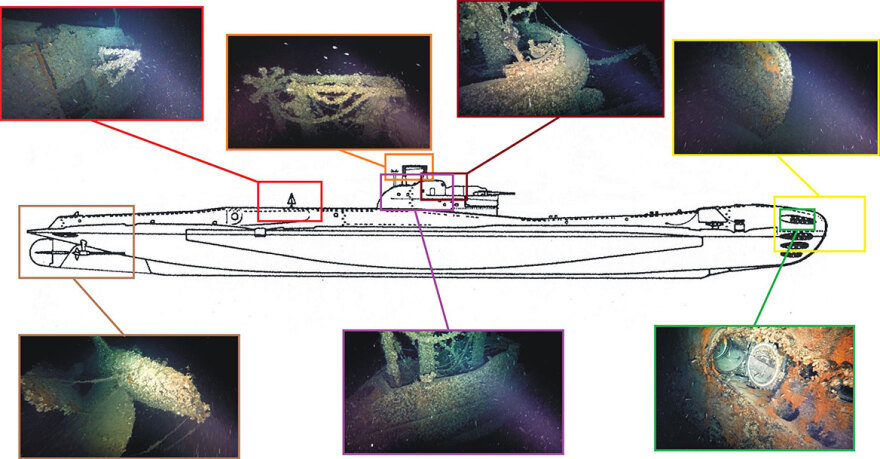
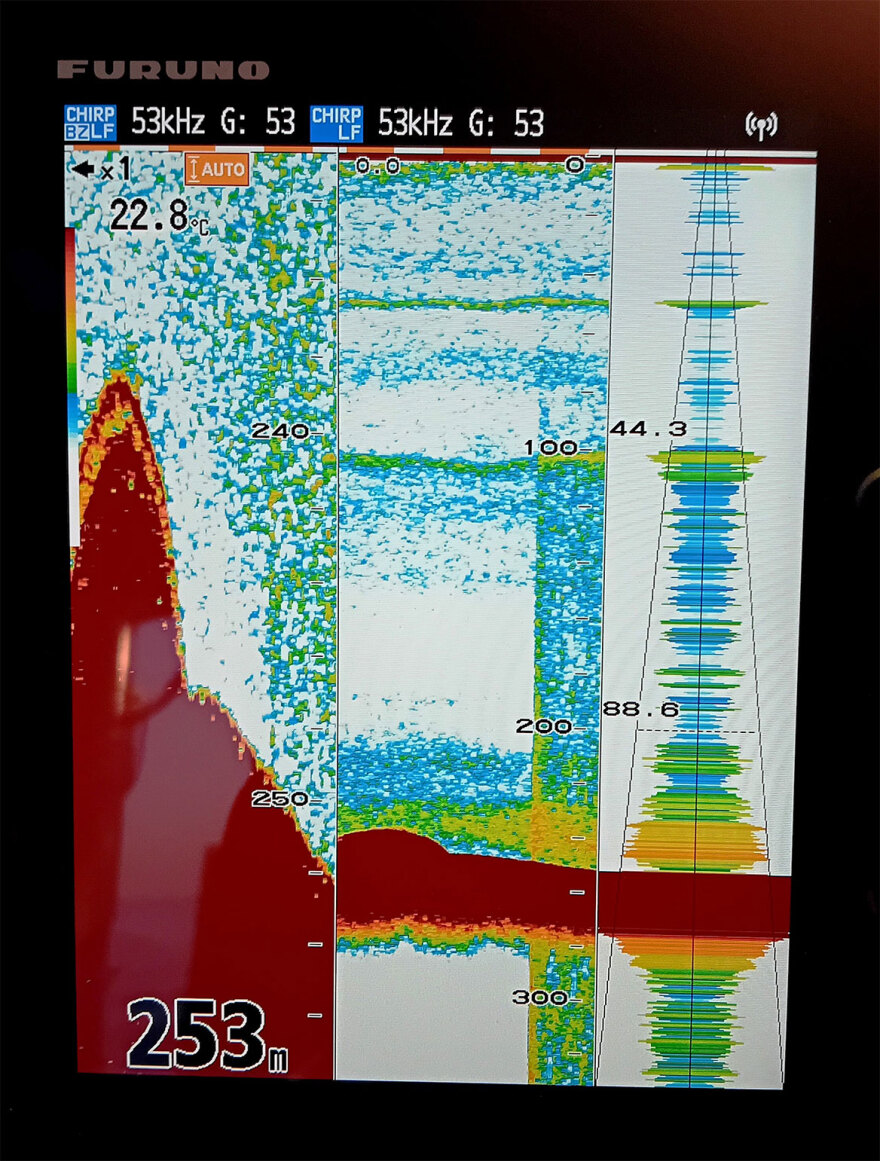 Historical twist
Historical twistResearch in Greek, German and British archives
The team proceeded to investigate all the German minefields that the Germans had set up in the Aegean and found that the DRACHE minesweeper on 26 September 1943 laid five anti-submarine minefields with 287 mines north of Donousa, on the day the submarine TROOPER set off from Vyritto on her last mission. It was the area in which the submarine’s commander was ordered to patrol between 6 and 9 October 1943, before his ordered move to Leros.
The correctness of this theory was yet to be proven in practice by the results of field investigations. The 15th in a row and the last mission started in 2023 and this time not in the Dodecanese but in the heart of the Aegean Sea, in the Icarian Sea. Icario is, as Mr. Thoktaridis says, one of the most difficult seas with strong winds, waves and strong underwater currents. However, continuous and persistent research has paid off.
The wreck of HMS TROOPER was located in international territorial waters north of Donoussa, at a depth of 253 meters, on one of the five German minefields that DRACHE had laid on 26 September 1943.
The initial identification of the exact position of the wreck was achieved by a dual-emission CHIRP technology sonar.
In the final phase the identification was made using an unmanned submarine ROV of the Super Achille type.
HMS Trooper: findings “speak” from 253 meters deep
Eighty-one years after its loss, the first images of HMS Trooper from -253 meters (830 ft) in the Icarian Sea are awe-inspiring.
The submarine entered one of the five minefields laid by the German minesweeper DRACHE a few days earlier and sank at dawn on 7 October 1943, dragging the 64 officers and sailors on board to the bottom.
According to Mr. Thoktaridis: “The 84-meter long TROOPER is cut into three distinct sections, bow, middle section and stern, which confirms a very violent sinking, following a mine explosion. The sinking of the submarine was caused by the explosion of a German EMF-type mine containing 350 kg of hexanite (a mixture of ammonium nitrate and trinitrotoluene known as Hexanite). The result of the explosion was the immediate and rapid sinking of the submarine, with the submarine breaking into three pieces. First the bow was sunk, then the stern and lastly, the middle part which remained on the surface for a few minutes.”
The bow and stern lie on the seabed in close proximity, while the submarine’s turret has broken away and is located much further away. The scene is eerie…
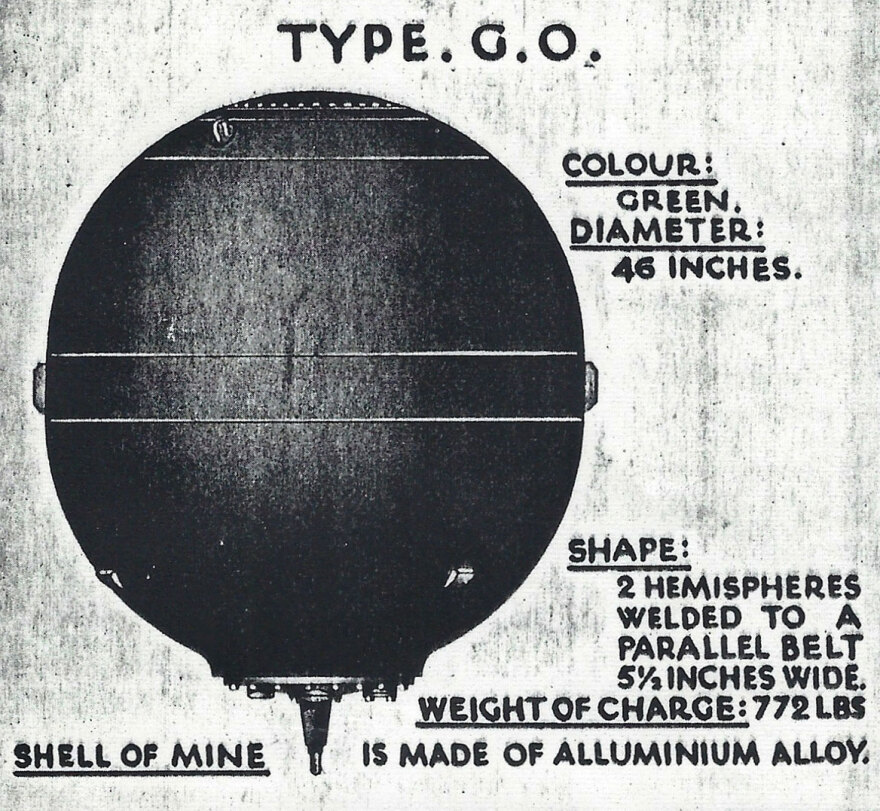
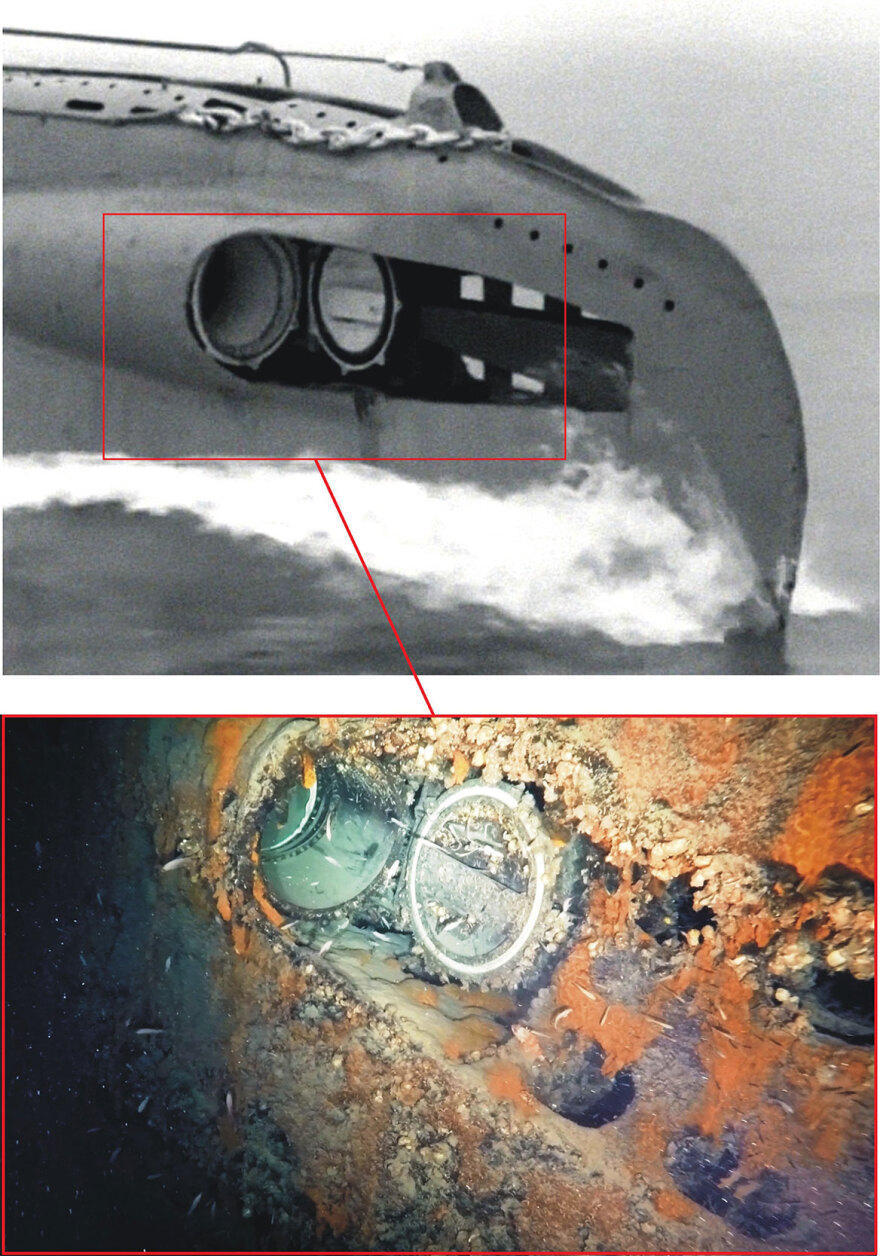 Bow section
Bow sectionThe bow has been laid on the bottom with a fore and aft (forward) inclination of 5 degrees. The cap of torpedo tube number 7 is open and the torpedo is missing. The caps of the other torpedo tubes are closed.
The bow section has a total length of 29 meters. The break has been made in number 55 where the crew’s accommodation compartment for the sailors was located. On the lower starboard side there is a longitudinal crack 4 meters long as well as inward deformation of plates from the shock wave of the explosion caused by the mine. The forward depth rudder is folded up, an indication that, together with the lowered periscopes and the open manhole in the turret, leads us to the conclusion that the submarine was on the surface at the time of the explosion.
Turret
It shows a starboard call of 7 degrees. The combat and observation periscopes are down as well as the airborne radar antenna. The turret’s manhole is open and the controls are in the forward position semi-first. The manholes leading to the gun are closed and the whole gun is absent from its base. The inner door leading to the engine room is open. The turret section has been broken off at No. 98 at the location of the engine room watertrap.
Stern section
The stern section has suffered the least damage and is the longest at 32.5 meters long. It exhibits a large draw of 43 degrees starboard. The Direction Finder antenna is visible on the deck, in excellent condition. The depth and directional rudders are in the zero position. The cap of the number 10 external torpedo tube has been opened and the torpedo is sticking out 2.2 meters. The external torpedo tube No 9 is closed.
The identity of the legendary submarine HMS Trooper
Length: 273.5 feet – 83.36 m
Width: 26.6 feet – 8.10 m
Displacement: 1327 tons (surface) 1090 tons (standard) 1571 tons (submerged)
Speed: 15½ knots (surface) 9 knots (submerged)
Range: 8000 nm with 10 knots on surface, 80 nm with 4 knots underwater
Maximum depth: 300 ft – 91.4 m
Armament: 11 torpedo tubes (6 aft at the bow and 5 outboard), 1 4-inch gun.
